In a dramatic turn of events, new details have emerged surrounding the January 1, 2025, explosion involving a Cybertruck in Las Vegas. What began as a mysterious incident has now unraveled into a complex case involving advanced technologies, psychological struggles, and troubling uses of artificial intelligence.
The Incident: What We Know
The explosion occurred near the Trump International Hotel in Las Vegas when a Cybertruck loaded with explosive materials was intentionally detonated. The suspect, identified as Matthew Allen Lburg, tragically took his own life during the event, leaving behind a six-page manifesto detailing his motivations, grievances, and plans.
Investigators have revealed that Lburg used a combination of racing fuel, fireworks, and explosive targets to create a vehicle-borne improvised explosive device (VBIED). The explosion, described as a fuel-air event rather than a full detonation, could have been far more catastrophic had all the materials been properly activated.
The Role of AI in Planning the Attack
One of the most startling revelations in this case is the suspect’s use of generative AI, including ChatGPT, to plan the attack. According to law enforcement officials:
- Lburg used ChatGPT to calculate the amount of explosives required for maximum impact.
- He sought guidance on sourcing fireworks and their equivalence to more powerful explosives like TNT.
- The suspect also used AI to explore ways to purchase materials anonymously, avoiding personal identification.
This marks one of the first known instances in which artificial intelligence was explicitly used to assist in the planning of a violent act on U.S. soil. Authorities have expressed deep concern about the implications of this case, calling it a “game-changer” for national security.
Digital and Physical Evidence
The investigation revealed extensive planning on the suspect’s part, as evidenced by:
- Digital Logs: Notes on his phone titled “surveillance log” chronicled his activities and preparations, including purchasing firearms, renting the Cybertruck, and acquiring explosive materials.
- Video Footage: Surveillance footage shows Lburg pouring racing fuel into the Cybertruck’s cargo area before the explosion.
- Recovered Firearms: An AR pistol and a Desert Eagle handgun were found at the scene, one of which was used in the suspect’s suicide.
Despite the detailed preparation, not all of Lburg’s plans came to fruition. Investigators noted that while the explosion was significant, it fell short of achieving a full detonation, likely due to technical miscalculations.
Psychological and Motivational Insights
The manifesto left by Lburg offers a glimpse into his state of mind. He described feelings of despair, PTSD from his military service, and a sense of being surveilled. While he expressed anger at political and social issues, including the U.S. withdrawal from Afghanistan, he also stated that he did not intend to harm others, focusing solely on making a public statement through his actions.
The document further revealed his struggles with mental health, including references to substance use and haunting memories from his past. His writings reflect a troubled individual grappling with personal demons and societal frustrations.
Implications and Concerns
The Las Vegas explosion raises critical questions about the accessibility of dangerous knowledge through AI and the broader implications for public safety:
- AI Regulation: Law enforcement officials are urging policymakers to address the potential misuse of AI in criminal activities. The incident underscores the urgent need for oversight and safeguards to prevent similar occurrences in the future.
- Mental Health Awareness: Lburg’s case highlights the importance of early intervention and support for individuals facing mental health challenges, particularly those with military backgrounds.
- Enhanced Security Measures: The use of VBIEDs and AI-driven planning tools calls for heightened vigilance and advancements in counterterrorism strategies.
A Call to Action
As the investigation continues, authorities are working tirelessly to piece together the full scope of this incident. Law enforcement agencies, including the FBI, ATF, and local police, are collaborating to analyze evidence and prevent future tragedies.
The Las Vegas Cybertruck explosion serves as a sobering reminder of the evolving threats posed by technology and the need for proactive measures to ensure public safety.
